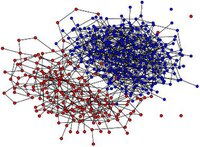
Photo from wikipedia
We introduce a socially motivated extension of the voter model in which individual voters are also influenced by two opposing, fixed-opinion news sources. These sources forestall consensus and instead drive… Click to show full abstract
We introduce a socially motivated extension of the voter model in which individual voters are also influenced by two opposing, fixed-opinion news sources. These sources forestall consensus and instead drive the population to a politically polarized state, with roughly half the population in each opinion state. Two types social networks for the voters are studied: (a) the complete graph of $N$ voters and, more realistically, (b) the two-clique graph with $N$ voters in each clique. For the complete graph, many dynamical properties are soluble within an annealed-link approximation, in which a link between a news source and a voter is replaced by an average link density. In this approximation, we show that the average consensus time grows as $N^\alpha$, with $\alpha = p\ell/(1-p)$. Here $p$ is the probability that a voter consults a news source rather than a neighboring voter, and $\ell$ is the link density between a news source and voters, so that $\alpha$ can be greater than 1. The polarization time, namely, the time to reach a politically polarized state from an initial strong majority state, is typically much less than the consensus time. For voters on the two-clique graph, either reducing the density of interclique links or enhancing the influence of news sources again promotes polarization.